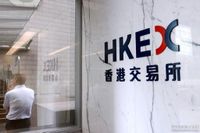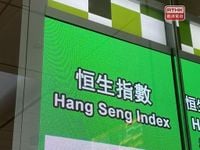Major stock markets across the Asia-Pacific region experienced significant declines on April 7, 2025, following the United States' imposition of reciprocal tariffs on trade. The impact was particularly pronounced in Hong Kong, where the Hang Seng Index fell below the critical 21,000-point mark, closing at 20,730 points, a staggering drop of 2,119 points or 9.28% during the auction session.
The market turmoil comes on the heels of China announcing countermeasures against U.S. tariffs, which included an additional 34% tax on all goods imported from the United States. This escalation in trade tensions has fostered a climate of panic among investors, leading to widespread sell-offs in various sectors.
As the trading day commenced, the Technology Index in Hong Kong plummeted by over 11%, settling at 4,721 points. Blue-chip stocks were not spared from the fallout, with many experiencing declines of around 15%. Notable technology giants such as Alibaba, Tencent, and Xiaomi saw their shares drop significantly, with Alibaba falling 12.5% to HK$108, Tencent down 11.2% to HK$441.8, and Xiaomi decreasing by 12.4% to HK$40.2.
In addition to the technology sector, other industries also felt the sting of the tariffs. The benchmark HSBC opened at HK$73.5, reflecting a decrease of approximately 14.6% from its previous closing price. Export and shipping stocks, particularly vulnerable to global trade dynamics, continued their downward trajectory with companies like Sinotrans and COSCO Shipping Holdings experiencing drops of 11.5% and 12.1%, respectively.
Market analysts have noted that the Hong Kong stock market has reached its lowest point since February 2025, effectively erasing all gains made since the Lunar New Year. The pervasive selling pressure is indicative of the broader unease among investors regarding the sustainability of economic growth amidst escalating trade conflicts.
In stark contrast to the overall market trend, some rare earth-related stocks bucked the downward movement. Jiuling Technology and Ximeng Technology saw their shares rise by more than 10%, while Jinli Permanent Magnet, China Rare Earth, and Northern Rare Earth increased by over 5%. This divergence highlights the complex nature of market responses to geopolitical events.
As the situation unfolds, the implications of the U.S. tariffs and China's retaliatory measures continue to reverberate throughout the global financial landscape. Investors remain on high alert, closely monitoring developments that could further impact market stability and economic growth.
The broader implications of these trade tensions extend beyond immediate stock market reactions. Economists warn that prolonged uncertainty could stifle investment and consumer confidence, potentially leading to slower economic growth in both the U.S. and China. The interconnectedness of global markets means that the repercussions of these tariffs could be felt far and wide, affecting economies and industries across the globe.
In the gold market, spot gold also faced downward pressure, falling by more than 1% to dip below the US$3,000 per ounce threshold. This decline reflects a flight to safety among investors amid the turbulent market conditions.
As countries grapple with the ramifications of these trade policies, the focus will undoubtedly shift to how governments respond to the challenges posed by escalating tariffs and international trade disputes. The coming weeks will be critical in determining the trajectory of both the markets and the global economy.
In summary, the imposition of reciprocal tariffs by the U.S. has triggered a wave of panic in the Asia-Pacific markets, with Hong Kong's Hang Seng Index suffering a significant blow. As trade tensions escalate, the response from investors and the broader economic implications remain to be seen. The unfolding situation serves as a stark reminder of the fragility of global trade relations and the potential for rapid shifts in market sentiment.






